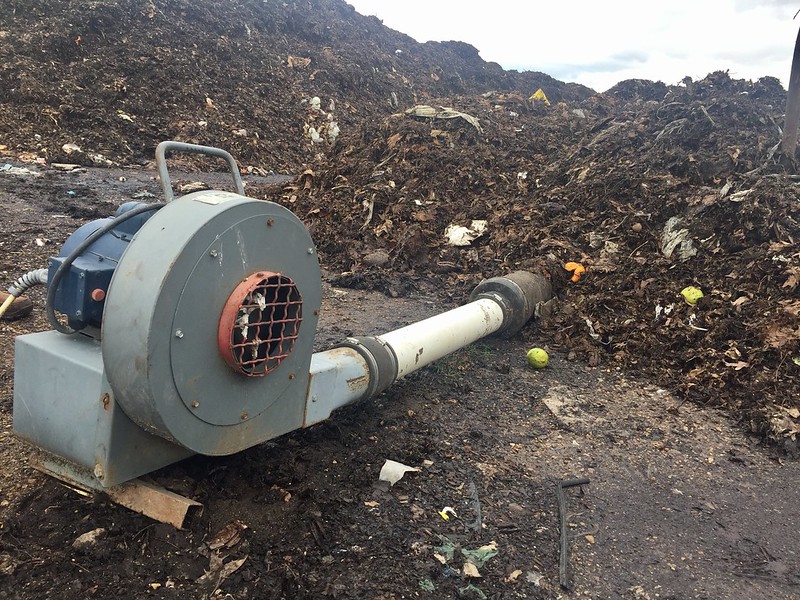Composting
Composting is a sustainable waste management practice that reduces greenhouse gas emissions, enhances soil health, and sequesters carbon dioxide. This page explores the progress, challenges, and future directions of composting efforts.

Aerating a compost pile at a commercial compost facility
job openings
View open jobs in this Solution
Example Companies
- BioCycle - Provides resources and information on composting and organics recycling.
- Cedar Grove - Operates large-scale composting facilities and produces compost products.
- Revolution Plastics - Focuses on recycling agricultural plastics and producing compostable products.
- Eco-Products - Manufactures compostable foodservice packaging.
- ReVive Organics - Develops composting systems and services for urban environments.
Overview
Composting gains attention for curbing greenhouse gases by enhancing soil health and sequestering carbon dioxide. Aerated composting accelerates the process, lowering landfill times and methane emissions. Compostable packaging helps reduce landfill waste and carbon dioxide.
Learn More
Progress Made
Significant advancements have been made in composting technologies and practices:
- Modern Composting Systems: Mitigate methane emissions from organic matter decomposition.
- Technologies: Include anaerobic digesters and aerated systems.
- Prominent Supporters: Organizations like the United States Composting Council, EPA, and businesses like EarthTechling and ReVive Organics.
Solutions by Sector
Residential
- Home Composting Systems: Small-scale compost bins and tumblers for household use.
- Community Composting: Local composting programs that serve neighborhoods and communities.
- Educational Programs: Initiatives to teach residents about the benefits and methods of composting.
Case Studies:
- Compost Now, USA: Provides residential composting services, collecting food scraps and yard waste from households (Compost Now).
- Litterless, USA: Offers resources and guides for starting home composting projects (Litterless).
- GrowNYC, USA: Runs community composting programs in New York City, diverting organic waste from landfills (GrowNYC).
Commercial
- Large-Scale Composting Facilities: Industrial composting operations that process large volumes of organic waste.
- Food Waste Collection: Services that collect food waste from restaurants, grocery stores, and food processors.
- Compostable Packaging: Development and use of packaging materials that can be composted.
Case Studies:
- Cedar Grove, USA: Operates large-scale composting facilities and produces high-quality compost products (Cedar Grove).
- Eco-Products, USA: Manufactures compostable foodservice packaging, reducing landfill waste (Eco-Products).
- Revolution Plastics, USA: Focuses on recycling agricultural plastics and producing compostable products (Revolution Plastics).
Agricultural
- On-Farm Composting: Techniques for farmers to compost crop residues and manure.
- Soil Amendments: Using compost to improve soil health and fertility.
- Carbon Sequestration: Leveraging compost to sequester carbon in agricultural soils.
Case Studies:
- Rodale Institute, USA: Conducts research and provides training on organic farming and composting (Rodale Institute).
- Kiss the Ground, USA: Promotes regenerative agriculture practices, including composting, to improve soil health (Kiss the Ground).
- Vermont Compost Company, USA: Produces high-quality compost for agricultural use, enhancing soil fertility and crop yields (Vermont Compost Company).
Lessons Learned
- Effective GHG Reduction: Composting is effective in reducing greenhouse gas emissions.
- Scalability: Composting is feasible on varying scales, from small household systems to large industrial operations.
- Management: Requires careful management to ensure optimal conditions for decomposition.
- Environmental and Health Benefits: Positively impacts the environment and public health.
- Holistic Strategy: Essential as part of a holistic climate strategy.
- Promotion: EPA and USDA promote composting's benefits, reducing emissions by up to 34%.
Challenges Ahead
- Infrastructure: Lack of infrastructure and government support hinders wider adoption.
- Awareness: Limited awareness about composting's climate benefits.
- Funding: Securing funding for composting programs and facilities.
- Technical Expertise: Need for trained professionals to manage composting operations.
Best Path Forward
- Mandatory Composting: Enforce mandatory composting for households and businesses.
- Legislation and Regulation: Implement supportive policies and regulations.
- Public Engagement: Increase public engagement through education and advocacy.
- Technical Assistance: Provide technical assistance and training for composting practices.
- Financial Incentives: Offer financial incentives to encourage composting adoption.
Image credit: Unsplash